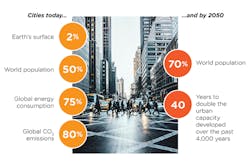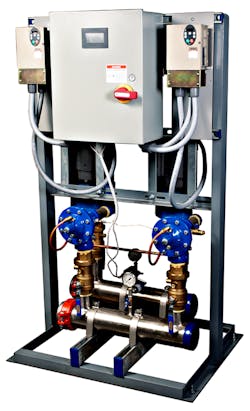The way many Americans choose to live is changing. In 2011, for the first time in nearly 100 years, the rate of urban population growth outpaced that of the suburbs. In the past, the goal for many was to get out of the cities and find better lives in the suburbs. Now more Americans are actively choosing cities. This trend has continued for the last five years and is now being strengthened by millennials relocating to cities to start the next phase of their lives.
The urbanization trend has put many pressures on cities ranging from parking to infrastructure. Construction of new buildings has increased in many areas and owners of existing buildings are looking for new ways to keep tenants happy while managing costs. For each of these three groups, pumping water is a growingconcern. Issues such as how to meet the demand, how to reach higher floors and how to do both without breaking the bank are just a few issues consistently being dealt with.
Water pressure can vary by municipality and by a neighborhood within an individual municipality. For many urban buildings, the pressure from the nearest pumping station alone is not enough to reach those in the top floors. Modern buildings require their own systems that can increase water pressure as needed.
A building manager’s job would be easy if the pressure from the municipal pumping station and the load on the top floor were consistent. Unfortunately, this is almost never the case. However, new technology allows for those systems to respond to changing intake pressures and changing demands more easily and efficiently than before using booster pump skids. These small internal pumping stations are placed approximately every 10 floors within a building to increase the water pressure within their zones.
HYFAB booster pump skid
The booster pump skid is typically manufactured separately from the building and installed as a single unit on the designated floor. One manufacturer specializes in thoughtfully engineered, energy-efficient pumping packages for various heating, ventilating and air conditioning (HVAC) or plumbing applications. These are mounted on a single frame and sized to order based on a building’s needs. The skids are composed of suction pumps, service valves and pressure gauges connected to the plumbing, as well as variable speed drives and programmable logic controllers (PLCs) linked to the building control system.
Maximizing efficiency
Pump system efficiency has been a large industry topic with groups like the Air Conditioning, Heating and Refrigeration Institute (AHRI) that released its Standard 1210 (IP) and 1211 (SI) Performance Rating for Variable Frequency Drives (VFDs) in 2013 to address system efficiency by focusing on the VFD. More recently, the U.S. Department of Energy (DOE) provided guidance through "10 CFR Parts 429 and 431 — Energy Conservation Program: Test Procedure for Pumps," which lays out protocols for testing pump systems’ efficiency.
Similar guidelines have been developed specifically for buildings. The American Society of Heating, Refrigerating and Air-Conditioning Engineers updated the world’s most adopted building energy code — ASHRAE 90.1 — which outlines minimum energy code standards for new buildings and new equipment in existing buildings (except low-rise residential). The code includes stipulations for a building’s envelope as well as HVAC, service water heating, power and lighting systems.
The most recent update to this code, ASHRAE 90.1-2010, is a joint effort between ASHRAE and the DOE to push commercial buildings toward net-zero performance, which means buildings should produce as much energy from renewable resources as they consume. Within that guideline, Section 10.4 states that pressure booster systems might no longer be controlled by set points that are based on pump discharge pressures. Instead, the pressure boosters must be controlled by demand, which typically means installing a pressure sensor remotely in the system, usually at the "critical fixture" or the highest point in the system. The sensor will need to start the pressure booster and control its speed, and the booster pumps must turn off when there is no flow. The new standard also prohibits the use of pressure-reducing valves (PRVs) to reduce the pressure of water supplied by booster system pumps. While the standard does not prohibit using PRVs for zones or individual floors, it does prohibit pumping all of the water to a high pressure and then reducing it at the booster pump.
The bottom line for buildings’ systems is that the previous technology of constant speed pressure boosters is no longer feasible. While constant speed pressure boosters deliver consistent pressure, they use a lot of energy. Also, previous techniques using valves to regulate pressure should not be used. A variable speed pressure booster that bases its set point on the building’s most remote fixture, instead of the reading seen at the pump discharge, will allow the pump to run at a lower speed. This is possible because the controller is able to take into account the reduction in piping pressure at a lower flow, which can translate into a significant operating cost savings for a variable speed pump system.
The critical technology within the variable speed pump system is the variable speed drive attached to that pump. HYFAB, as an example, uses a variable speed drive for its systems to achieve the balance between pressure/flow and varying demand. This drive is certified by the AHRI for meeting Standard 1210 for performance.
Maximizing control
As the demands on building systems increase, so do the operating costs. Building managers look for ways to reduce those costs and often focus on efficiency. Pumps are at the heart of any HVAC/plumbing system and can represent up to 15 percent of a large building’s total energy use. Energy costs associated with pumping applications represent approximately 40 percent of the total cost of ownership for the life of that pump.
This puts a greater emphasis on intelligent pumping within buildings and the need for a control system that allows building managers to easily manage a system that can adapt to changing conditions.
New technology within modern VFDs allows for flexibility within the system to gain efficiency. When paired with a PLC, these systems offer managers new levels of insight and control of the process. Three key examples of this include:
- The ability to program in the pump curve to match the drive functionality with the needs of the building for efficient operation.
- The ability to monitor water flow without sensors using algorithms within the drive to have a real-time understanding of the process.
- The ability to stage multiple pumps within a single drive for control and efficiency without the added expense of purchasing or operating individual drives on each pump.
Connecting these systems into a single building control system is important. With new technologies, this is easier than ever with multiple communication formats available for these controls, such as BACnet, that allow each to communicate with each other and the central control system. Many of these systems also provide additional benefits such as remote system monitoring and predictive maintenance through preloaded software blocks and connectivity via Ethernet, embedded web server or Wi-Fi.
Leveraging modern drive and PLC technology provides a holistic look into a building’s pumping system and, in turn, a new level of control. From here, programs can be put in place to match the dynamic needs of the building for greater efficiency. With that in place, building managers can closely monitor the system and energy consumption of individual units, identify inefficiencies quickly and take action to make adjustments as needed to improve them.
References
- http://www.cbreglobalinvestors.com/research/publications/Documents/Special%20Reports/US%20Urbanization%20Trends_JAN%202015.pdf
- http://download.schneider-electric.com/files?p_Reference=998-2095-02-19-14AR0-US&p_EnDocType=White%20Paper&p_File_Id=941447123&p_File_Name=Pump+-+TCO+White+Paper.pdf
Jack Creamer is Schneider Electric’s market segment marketing manager — pumping equipment. He is actively involved in key industry associations such as the Hydraulic Institute and the Submersible Wastewater Pump Association. He also represents Schneider’s membership in numerous industry organizations.



